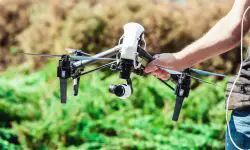As an Amazon Associate I earn from qualifying purchases.
When you drive a car, ride a bike or even sail a boat, it’s fairly easy to know where you’re going. This is because it’s easy to distinguish the front and the back of the vehicle. In addition, you’re typically always sitting in a position that faces forward. We tend not to pay attention to simple things like this, but it actually contributes a lot to the ease of using those vehicles.
How you typically pilot a drone
When you first use a drone, you might find that there’s no sense of direction since you’re looking at the vehicle from a different perspective. Your view stays fixed but the orientation of the drone changes as you pilot it. If you’ve ever driven a remote-controlled car then you may already know what this feels like. You have to think about driving from the perspective of the drone and not your own.
To make matters worse, the design of a drone needs to be fairly symmetrical due to the way it flies. This makes it even harder to know which direction the drone is facing and complicates things. It takes a bit of practice and muscle memory to think in terms of the vehicle’s orientation and not your view of it.
To help remedy this, manufacturers started putting colored light on the front of the drone to help you distinguish the front from the back. This can help at shorter distances, but if your drone goes too far then it’s unlikely that you’ll even be able to see the lights.
With these problems in mind, drone manufacturers developed “headless” mode. While the term is fairly ubiquitous, it may have different names such as “safe mode” depending on the type of drone you have. In this article, we’ll be explaining exactly what headless mode is, if it’s worth using and what the pros and cons of it are.
What exactly is headless mode?
Headless mode is a common feature that is built into most modern drones. In technical terms, it enables the drone to remember its orientation when it takes off. Instead of moving relative to the direction the drone itself is facing, it will move relative to your own direction.
For example, if you take off your drone and turn it to face towards you, its direction is now opposite to your own. This means if you move the drone to the left, it will move to the right from your viewpoint. This can be confusing for some people because it takes a while to adjust to the drone’s relative position as opposed to your own.
With headless mode on, the drone will move relative to your orientation and not it’s own. You can think of this as more like a video game. If you move left, the drone moves left regardless of its orientation. This means that your personal orientation is used as the “anchor” for the drone’s movements. With headless mode on, you can expect to control the drone more easily as a beginner and focus on taking better pictures and videos instead of stressing over your piloting skills.
Why use headless mode?
Headless mode may sound a little strange to anyone that’s used to piloting a drone the normal way, but there are actually a number of reasonable use cases for headless mode.
It’s perfect for beginners that are just learning to fly a drone. You don’t need to think about the drone’s orientation and you can simply move it in the direction you want by focusing on your own orientation.
There’s less chance of crashing since the drone feels more responsive to your controls. You’re less likely to get confused and crash the drone into a tree or house. This ultimately means less money spent on repairs and less chance of an accident.
Headless mode can be useful when you’re piloting the drone over a long distance. At extreme distances, it can be hard to see where the drone is facing. Though this can be remedied using a live camera feed, the distance could introduce other factors (such as video delay) that make it different for you to pilot it safely.
As you can see, headless mode is typically used by beginners to help them gain more confidence in flying their drone. However, there are a couple of niche use cases that can make headless mode useful for professionals as well.
Why avoid headless mode?
While headless mode can make flying a drone easy for more people, there are some disadvantages that need to be pointed out. For starters, if you get used to flying a drone with headless mode, it might make it more difficult for you to transition over to non-headless mode. This usually isn’t a concern for most hobbyists but for anyone that wants to use their drone in a professional setting, you may want to consider learning to fly without the headless mode.
This is because some high-end drones don’t actually support headless mode as it’s considered a beginner-friendly feature. In addition, drones that support first-person view (FPV) won’t be compatible with headless mode since you rely on the video feed to orient the drone. If you’re flying a racing drone or using your drone to take photos and pictures, FPV is going to be the go-to standard. With an FPV view or goggles, flying in headless mode doesn’t make sense and you’ll need to get accustomed to regular mode.
Summary
In short, headless mode should be considered a beginner-friendly feature. While there are a couple of use cases where headless mode can be handy for professional use, we expect most power users to be accustomed to flying in FPV or regular mode. However, if you’re just starting out and are having trouble with the regular flying mode, headless mode can help you gain experience and confidence.
Amazon and the Amazon logo are trademarks of Amazon.com, Inc, or its affiliates.




